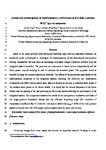Analytical investigation of hydrodynamic performance of a dual pontoon WEC-type breakwater
| dc.contributor.author | Ning, D-Z | |
| dc.contributor.author | Zhao, X-L | |
| dc.contributor.author | Zhao, M | |
| dc.contributor.author | Hann, Martyn | |
| dc.contributor.author | Kang, H-G | |
| dc.date.accessioned | 2017-07-25T08:24:17Z | |
| dc.date.issued | 2017-04 | |
| dc.identifier.issn | 0141-1187 | |
| dc.identifier.issn | 1879-1549 | |
| dc.identifier.other | 0 | |
| dc.identifier.uri | http://hdl.handle.net/10026.1/9636 | |
| dc.description | publisher: Elsevier articletitle: Analytical investigation of hydrodynamic performance of a dual pontoon WEC-type breakwater journaltitle: Applied Ocean Research articlelink: http://dx.doi.org/10.1016/j.apor.2017.03.012 content_type: article copyright: © 2017 Elsevier Ltd. All rights reserved. | |
| dc.description.abstract |
Based on the linear potential flow theory and matching eigen-function expansion technique, an analytical model is developed to investigate the hydrodynamics of two-dimensional dual-pontoon floating breakwaters that also work as oscillating buoy wave energy converters (referred to as the integrated system hereafter). The pontoons are constrained to heave motion independently and the linear power take-off damping is used to calculate the absorbed power. The proposed model is verified by using the energy conservation principle. The effects of the geometrical parameters on the hydrodynamic properties of the integrated system, including the reflection and transmission coefficients and CWR (capture width ratio, which is defined as the ratio of absorbed wave power to the incident wave power in the device width). It is found that the natural frequency of the heave motion and the spacing of the two pontoons are the critical factors affecting the performance of the integrated system. The comparison between the results of the dual-pontoon breakwater and those of the single-pontoon breakwater shows that the effective frequency range (for condition of transmission coefficient KT < 0.5 and the total capture width ratio ηtotal > 20%) of the dual-pontoon system is broader than that of the single-pontoon system with the same total volume. For the two-pontoon system, the effective frequency range can be broadened by decreasing the draft of the front pontoon within certain range. | |
| dc.format.extent | 102-111 | |
| dc.language | en | |
| dc.language.iso | en | |
| dc.publisher | Elsevier BV | |
| dc.subject | Linear potential flow theory | |
| dc.subject | Floating breakwaters | |
| dc.subject | Wave energy extraction | |
| dc.subject | Effective frequency range | |
| dc.title | Analytical investigation of hydrodynamic performance of a dual pontoon WEC-type breakwater | |
| dc.type | journal-article | |
| dc.type | Journal Article | |
| plymouth.author-url | https://www.webofscience.com/api/gateway?GWVersion=2&SrcApp=PARTNER_APP&SrcAuth=LinksAMR&KeyUT=WOS:000403994200009&DestLinkType=FullRecord&DestApp=ALL_WOS&UsrCustomerID=11bb513d99f797142bcfeffcc58ea008 | |
| plymouth.volume | 65 | |
| plymouth.publication-status | Published | |
| plymouth.journal | Applied Ocean Research | |
| dc.identifier.doi | 10.1016/j.apor.2017.03.012 | |
| plymouth.organisational-group | /Plymouth | |
| plymouth.organisational-group | /Plymouth/Faculty of Science and Engineering | |
| plymouth.organisational-group | /Plymouth/Faculty of Science and Engineering/School of Engineering, Computing and Mathematics | |
| plymouth.organisational-group | /Plymouth/REF 2021 Researchers by UoA | |
| plymouth.organisational-group | /Plymouth/REF 2021 Researchers by UoA/UoA12 Engineering | |
| plymouth.organisational-group | /Plymouth/Users by role | |
| plymouth.organisational-group | /Plymouth/Users by role/Academics | |
| plymouth.organisational-group | /Plymouth/Users by role/Researchers in ResearchFish submission | |
| dcterms.dateAccepted | 2017-03-22 | |
| dc.rights.embargodate | 2018-4-1 | |
| dc.identifier.eissn | 1879-1549 | |
| dc.rights.embargoperiod | 12 months | |
| rioxxterms.versionofrecord | 10.1016/j.apor.2017.03.012 | |
| rioxxterms.licenseref.uri | http://www.rioxx.net/licenses/under-embargo-all-rights-reserved | |
| rioxxterms.licenseref.startdate | 2017-04 | |
| rioxxterms.type | Journal Article/Review |


